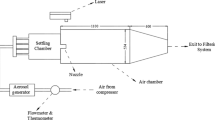Abstract
A series of dye flow visualization experiments are carried out in water to study the visible flow features in the near field of turbulent jets and to assess their usefulness in estimating the discharge rate of a turbulent jet in a homogeneous medium. The jet Reynolds numbers are 0.3–2.2 × 105. The large eddies at the core of the flow and the smaller eddies at the edge show disparate, independent length scales. Their convection speeds are more than an order of magnitude apart. Discharge rate estimates based on large-scale core features are useful. However, their reliability depends on a priori knowledge of the state of the bulk flow upstream of the discharge location. A useful method for estimating discharge rates based on the small-scale outer edge features is not obvious.














Similar content being viewed by others
References
Bhatti MS, Shah RK (1987) Turbulent and transition flow convective heat transfer in ducts. In: Kakaç S, Shah RK, Aung W (eds) Handbook of single-phase convective heat transfer. Wiley Interscience, New York, pp 4.1–4.166
Brown GL, Roshko A (1974) Density effects and large structure in turbulent mixing layers. J Fluid Mech 64:775–816
Coles D (1981) Prospects for useful research on coherent structure in turbulent shear flow. Proc Indian Acad Sci (Eng Sci) 4:111–127
Eastwood CD, Armi L, Lasheras JC (2004) The breakup of immiscible fluids in turbulent flows. J Fluid Mech 502:309–333. doi:10.1017/S0022112003007730
Hinze JO (1975) Turbulence. McGraw-Hill Inc., New York, NY
Hu H, Saga T, Kobayashi N, Taniguchi N (2003) Analysis of a turbulent jet mixing flow by PIV-PLIF combined system. J Vis7(1):33–42
Laufer J (1954) The structure of turbulence in fully developed pipe flow. NACA-TR 1174
Lawn CJ (1971) The determination of the rate of dissipation in turbulent pipe flow. J Fluid Mech 488(3):477–505
Mathew J, Basu AJ (2002) Some characteristics of entrainment at a cylindrical turbulence boundary. Phys Fluids 14(7):2065–2072
McNutt M, Camilli R, Guthrie G, Hsieh P, Labson V, Lehr B, Maclay A, Ratzel A, Sogge M (2011a) Assessment of flow rate estimates for the Deepwater Horizon/Macondo Well oil spill. Flow Rate Technical Group report to the National Incident Command, Interagency Solutions Group, March 10, 2011
McNutt MK, Camilli R, Crone TJ, Guthrie GD, Hsieh PA, Ryerson TB, Savaş Ö, Shaffer F (2011b) Review of flow rate estimates of the Deepwater Horizon oil spill. Proc Natl Acad Sci Published on line December 20, 2011. doi:10.1073/pnas.1112139108
Morton BR (1959) Forced plumes. J Fluid Mech 5:151–163
Nikuradse J (1932) Gesetzmäsigkeiten der turbulenten Stromung in glaten Rohren, Translated as ‘Laws of turbulent flow in smooth pipes’, NASA TT F-10, 359 (1966)
Nikuradse J (1933) Strömungsgesetze in rauhen Rohren. VDI-Forschungsheft no. 356. Translated as ‘Laws of Flow in Rough Pipes’, NACA-TM 1292 (1950)
Savaş Ö, Gollahalli SR (1986) Flow structure in near–nozzle region of gas jet flames. AIAA J 24(7):1137–1140
Schlichting H (1979) Boundary-layer theory, 7th edn. McGraw-Hill Inc., New York, NY
Sobel I, Feldman G (1968). A 3 × 3 isotropic gradient operator for image processing. In: Presented at a talk at the Stanford Artificial Project (indirect reference)
Turner JS (1973) Buoyancy effects in fluids. Cambridge University Press, Cambridge
Westerweel J, Fukushima C, Pederson JM, Hunt JCR (2005) Mechanics of the turbulent-nonturbulent interface of a jet. Phys Rev Lett 95:174501
Wygnanski IJ, Champagne FH (1973) On transition in a pipe. Part 1. The origin of puffs and slugs and the flow in a turbulent slug. J Fluid Mech 59:281–335
Yule AJ (1978) Large-scale structure in the mixing layer of a round jet. J Fluid Mech 89:413–432
Acknowledgments
Late Gregory McCauley of UC Berkeley helped with the experiments. Franklin Shaffer of NETL made numerous helpful comments on the manuscript. No extramural support was used for this work. The author was a member of the Flow Rate Technical Group-Plume Team assembled by the United States Geological Survey, which provided discharge rate estimates during the Gulf of Mexico oil spill in 2010.
Author information
Authors and Affiliations
Corresponding author
Rights and permissions
About this article
Cite this article
Savaş, Ö. A visual study in the near field of turbulent jets and implications for estimating accidental discharges. Exp Fluids 53, 1501–1514 (2012). https://doi.org/10.1007/s00348-012-1372-7
Received:
Revised:
Accepted:
Published:
Issue Date:
DOI: https://doi.org/10.1007/s00348-012-1372-7




